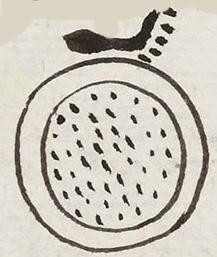Iztapan (Mdz38r)
This compound glyph for the place name Iztapan (perhaps "On the Salt [Flats)") features a bird's eye view of a round glyph for salt (with small dots inside) and a black footprint above that. The salt has two large concentric circles (black ink drawings) that contain the dots, which represent grains of salt. The footprint (a semantic indicator for the locative suffix -pan, on) is headed in the direction of the viewer's right.
Stephanie Wood
The footprint can stand for the verb pano, to cross over, especially when it appears above the main component, and this provides the locative suffix for in or on, -pan. [See Gordon Whittaker Deciphering Aztec Hieroglyphs, 2021, 101.] The result can therefore be a salty landscape feature that people cross over.
While there is no water in this visual, and -pan was added to a stem ending in the letter "a," it could be that the -apan locative suffix is still relevant, perhaps suggesting that this community was near salt water or some water beds were salt was made.
Stephanie Wood
yztapan. puo
Iztapan, pueblo
Stephanie Wood
c. 1541, but by 1553 at the latest
Stephanie Wood
salt, feet, cross over, crossing over, nombres de lugares

izta(tl), salt, https://nahuatl.wired-humanities.org/content/iztatl
pan(o), to cross or cross over, https://nahuatl.wired-humanities.org/content/pano
-pan (locative suffix), https://nahuatl.wired-humanities.org/content/pan
-apan (locative suffix), on or at the waters of, https://nahuatl.wired-humanities.org/content/apan-0
Codex Mendoza, folio 38 recto, https://digital.bodleian.ox.ac.uk/objects/2fea788e-2aa2-4f08-b6d9-648c00..., image 86 of 188.
The Bodleian Libraries, University of Oxford, hold the original manuscript, the MS. Arch. Selden. A. 1. This image is published here under the UK Creative Commons, “Attribution-NonCommercial-ShareAlike 3.0 License” (CC-BY-NC-SA 3.0).



